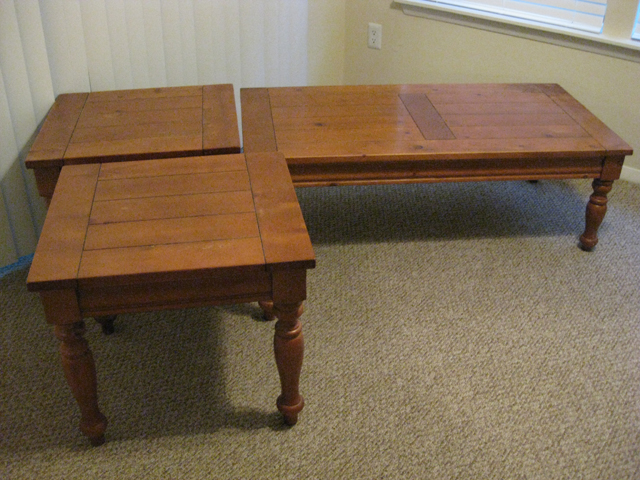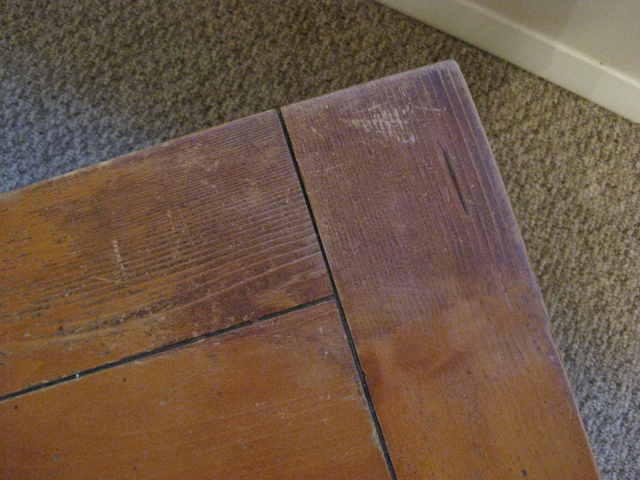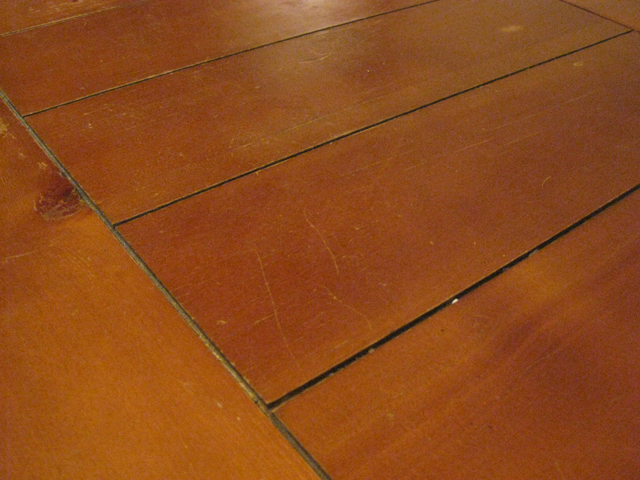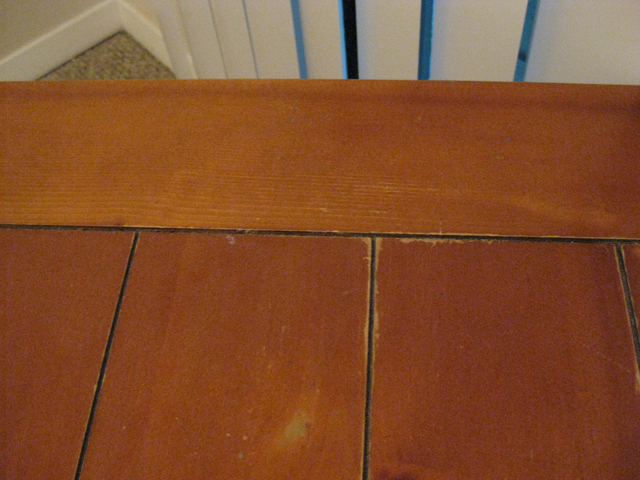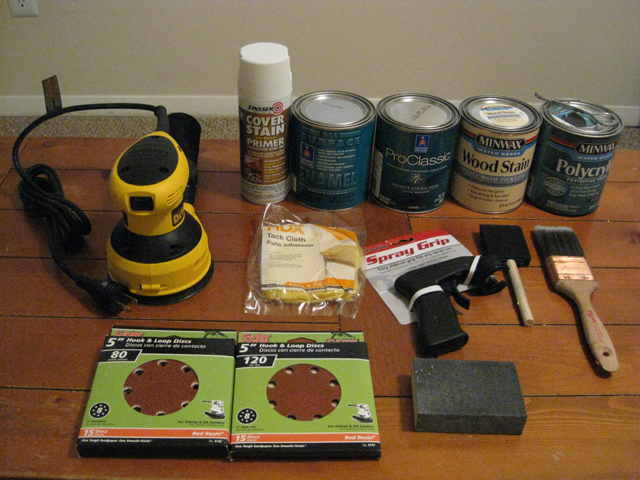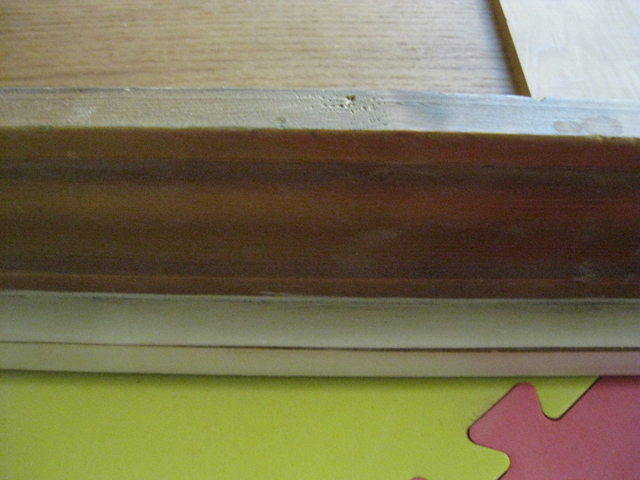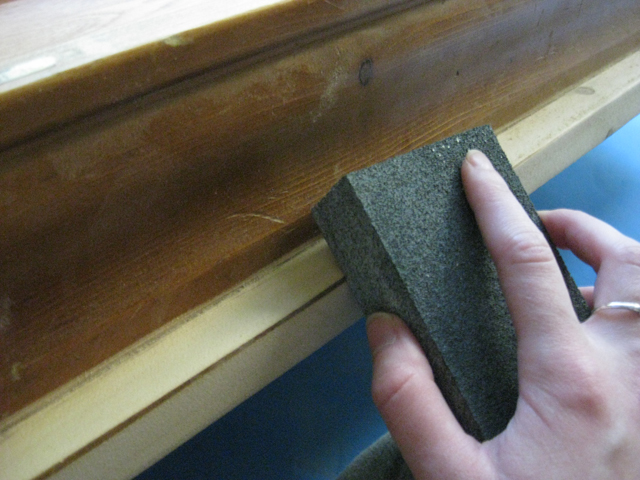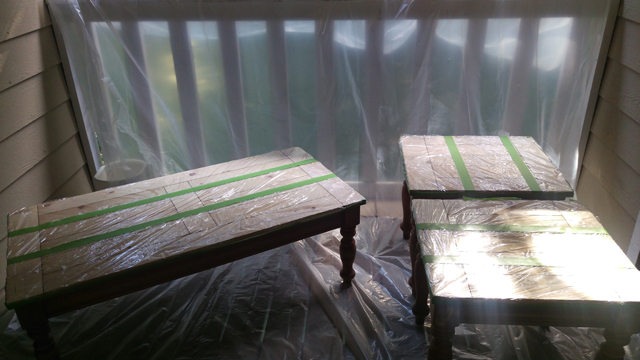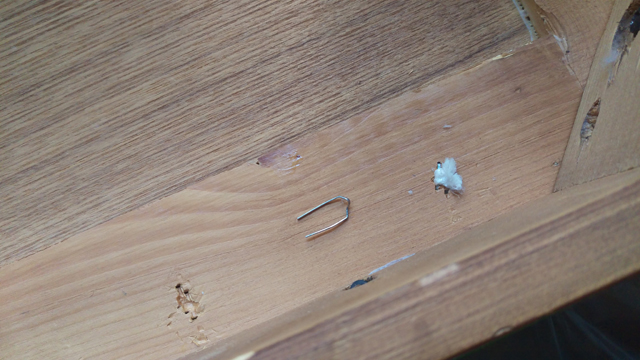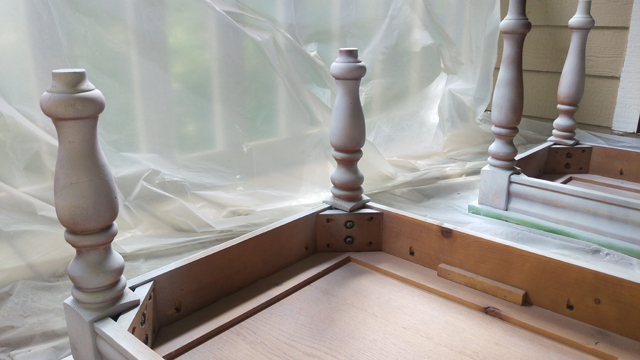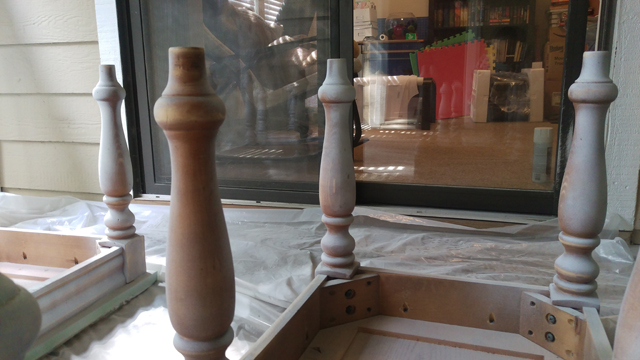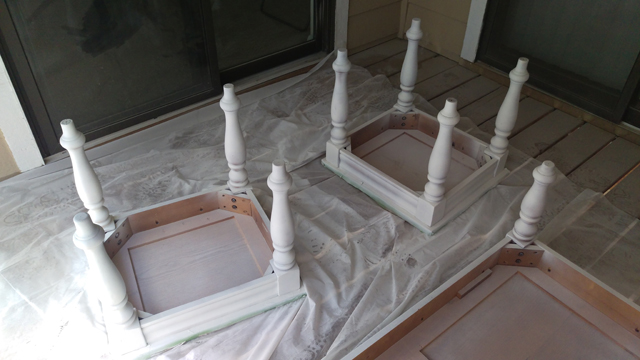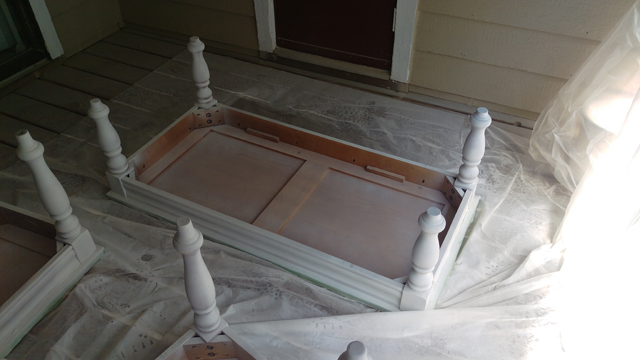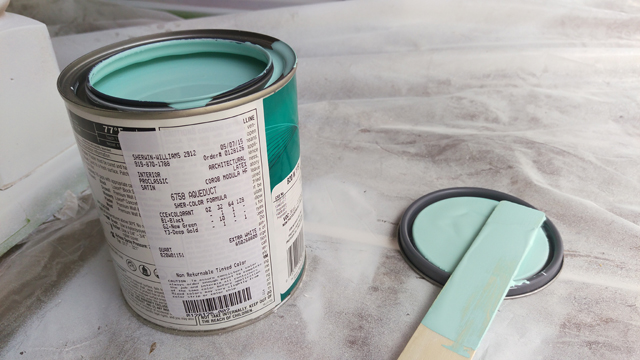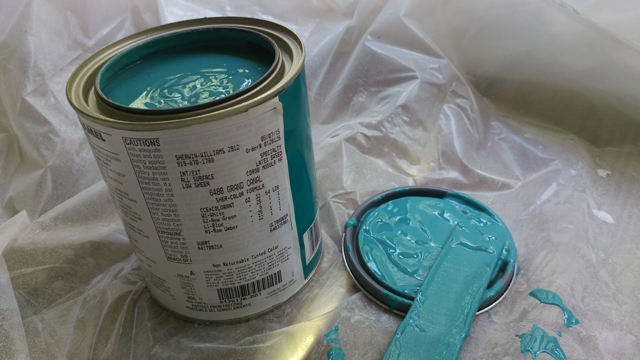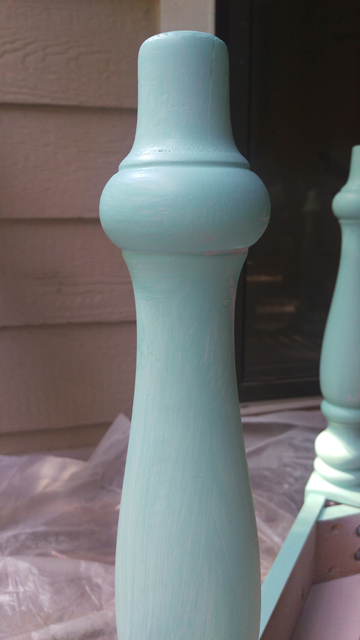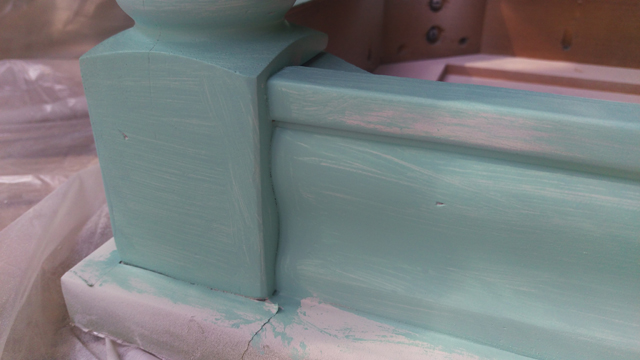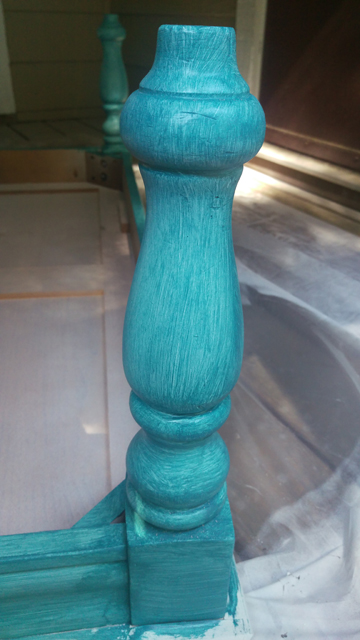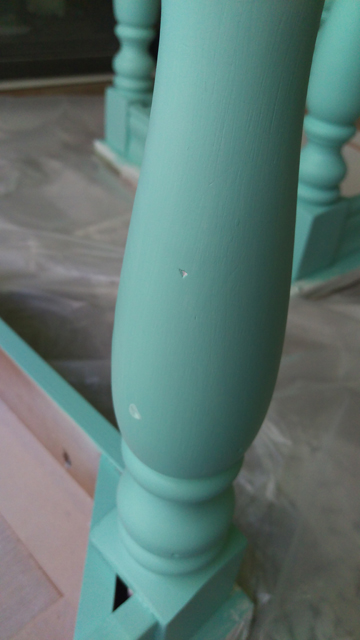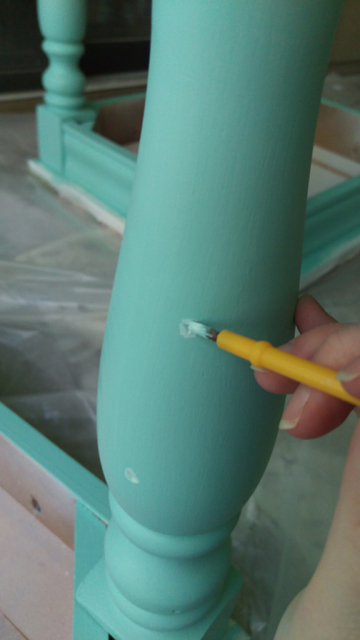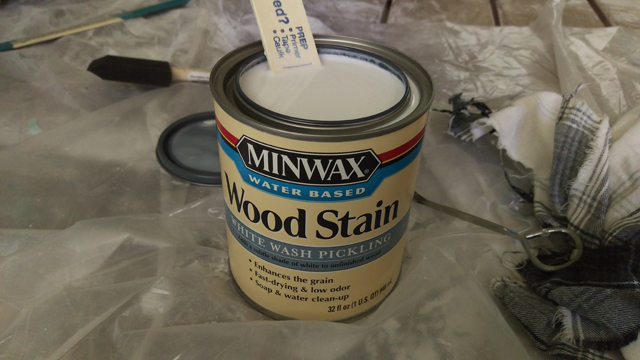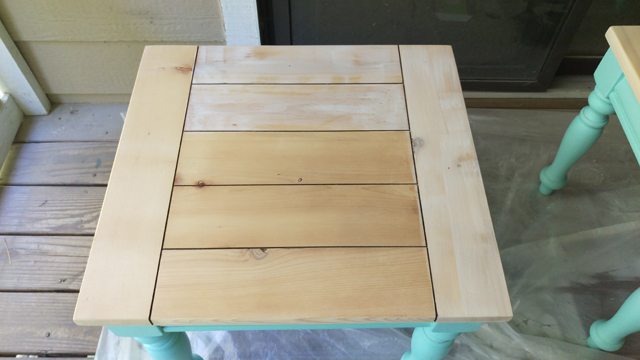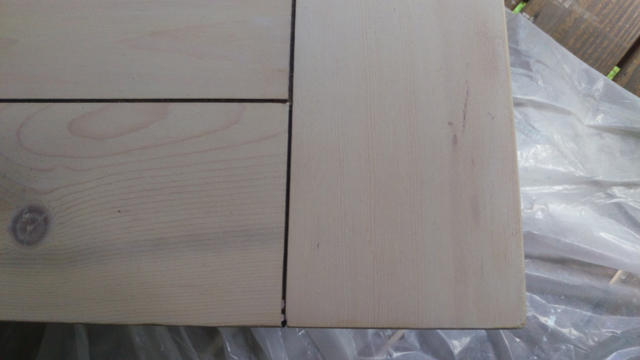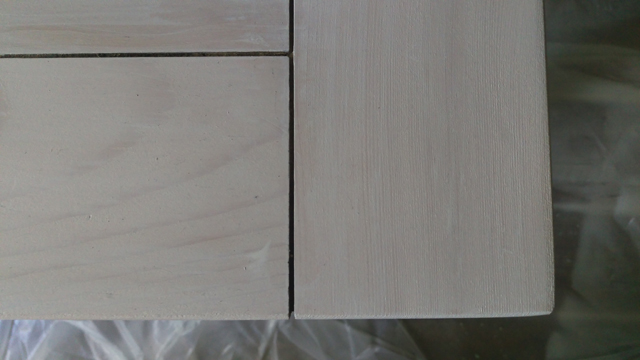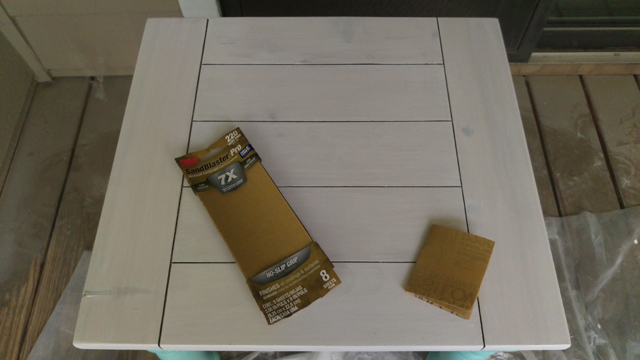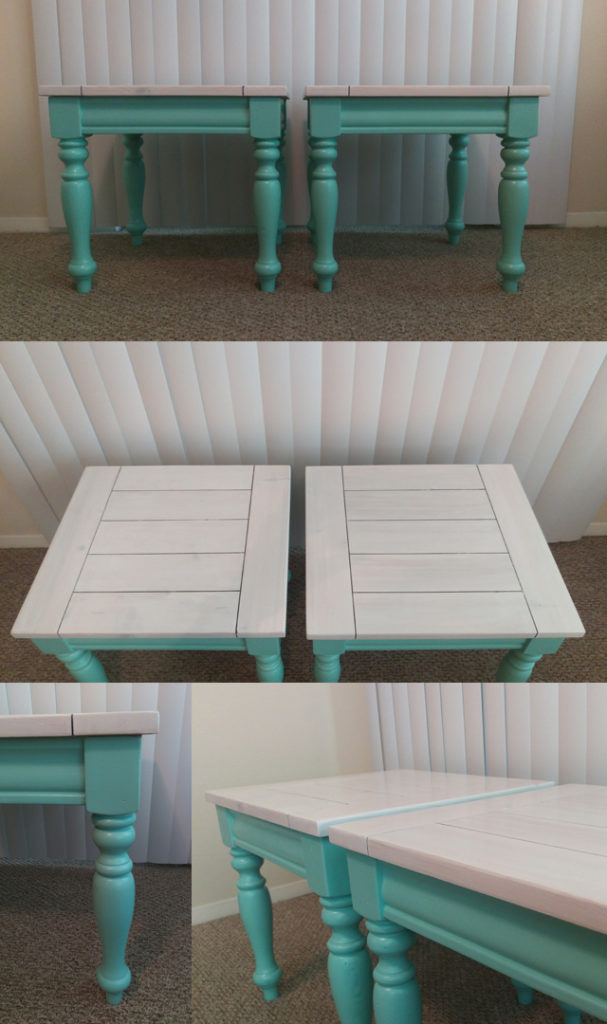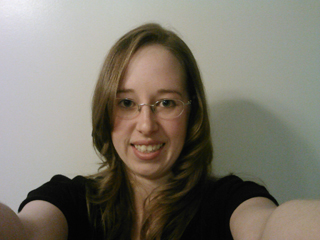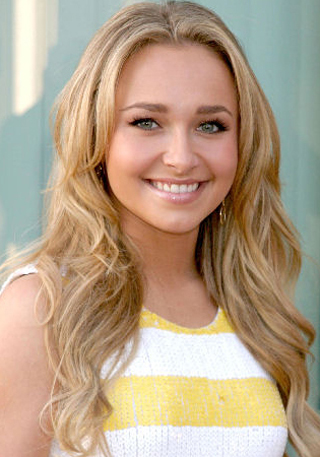As the first children to move away from home in our respective families, Justin and I have been the lucky recipients of hand-me-down furniture to furnish our various apartments. Some pieces came from our parents’ garages, remnants of decorating upgrades that hadn’t quite made it to a yard sale or thrift store. Others were freebies from friends who were moving and didn’t have space for them in their new digs. Our coffee table and two end tables fall into the latter category: a dear friend of my parents was down-sizing and wanted to pass them along rather than go through the trouble of selling them, so we gratefully accepted her generosity (while secretly high-fiving each other because we could swap out the stacked moving boxes we had been using as tables without spending a dime).
We’ve had the tables for nearly six years now, and they’ve served faithfully. But they definitely weren’t much to look at:
The orangey stain wasn’t our favorite (is it anyone’s?), but what really counted against them was the condition of the tops. On closer inspection you’ll see there was water damage…
…scratches…
…and chipped/scuffed stain.
Oh my. We were tempted to replace them, but everything we liked was a little out of our price range for now, and these tables still had plenty of useful life in them. I mean, they can still hold a lamp and a cold drink, so there was no call for sending them to the curb just yet. The only question that remained was whether to stain them or paint them. I couldn’t decide which idea I liked better, so I decided to do both: whitewash stain for the tops and a fun paint color for the legs. And since our living room is crying out for more color (rentals—what are ya gonna do?), I decided to spend a little extra money, take a bit of a design risk, and do the coffee table in a different color than the end tables.
I turned to veteran furniture makeover-er Kate of Centsational Girl to help me pull together a list of necessary materials. Although she’s done a couple two-toned pieces, her post on a blue bureau and her favorite furniture paint was the jumping off point for my own makeover process.
The sander, a DEWALT 5-inch variable speed random orbit sander (ROS), was purchased specifically for this project. I picked up 80 grit and 120 grit sanding discs at the same time, but later went back for 60 grit and 220 grit. I had the medium-grit sanding block from a previous project, but ended up buying 120 grit and 220 grit sandpaper because they were easier to maneuver around the tables’ curvy bits. I bought the spray grip for the primer on Kate’s recommendation, and I don’t think I’ll ever spray paint without one again, because it makes the process so much less hand-cramp-inducing. The foam brush was for the stain, the synthetic bristle brush was for the Polycrylic, and a short-handled natural-bristle angle brush (not pictured, whoops!) was for the paint. Also not pictured: drop cloth, respirator, safety goggles, and cotton rags.
Now for the fun bit: the paint and stain choices. Kate recommends a water-based alkyd enamel for furniture. It’s more expensive than latex, but it dries harder, which means no perpetually slightly tacky paint that tends to stick to anything left sitting on it too long. She notes that it’s especially good for things that will get a lot of use, like tabletops and dressers. Now, I wasn’t planning to use the paint on the tops of the tables, but we tend to drag and push on the coffee table a lot, and I know that I can get a little wild with my vacuuming, so I wanted a finish that wasn’t as likely to scratch, chip, or peel over time.
Of her two paint recommendations, I decided to go with the Sherwin Williams ProClassic Interior Waterbased Acrylic-Alkyd Enamel, because I know that Lowes sells SW paint. Well, it turns out they sell a very limited selection of it, and that’s not one of the products they carry. So I hit up an SW store to get swatches of colors I’d checked out online (an aqua and a dark teal) and get the paints mixed. When I went to place my order, the associate explained something that Kate doesn’t mention in her how-to: the ProClassic Interior Waterbased Acrylic-Alkyd Enamel is only available in the Extra White base, which means it can’t be used for dark colors like the teal I had picked. They gave me two alternatives: the ProClassic Interior Acrylic Latex Enamel, which comes in both the Extra White and Deep Base, and the All Surface Enamel Latex, which only comes in the Deep Base. Both are water-based products that dry hard like traditional oil-based enamels.
The ideal choice would have been to go with the Interior Acrylic Latex Enamel for both colors, but they were completely out of the Deep Base in satin finish—my preference for this project—and weren’t expecting any for at least a week. Being the impatient person that I am, I bit the bullet and decided to do the the lighter color in the Interior Acrylic Latex Enamel and the darker color in the All Surface Enamel Latex. I figured it would be a relatively low-risk way to see if I liked one over the other, because if I completely hated it, I could always go over it with a different paint and pretend that the first try never happened.
For the stain, I chose Minwax’s Whitewash Pickling Stain. It imparts a nice color that reads as white but still allows some of the wood grain to show through. Conveniently, it’s is also water-based: I already had half a can of Polycrylic left from a previous project that I could use for the topcoat, and I’m big on easy clean-up.
The first step was to sand the tops down to bare wood. I attacked them with the ROS with progressively finer sandpaper, starting at 60 grit and working my way to 220 grit. This took more patience then muscle, but it definitely took several evenings after work before I’d stripped all three tops. I then completely failed to take a photo of the stripped tops (or lost it somewhere between the camera and computer), so you’ll have to use your imagination.
Because the tops have a lip that hangs over the edge of the base by about a half inch, I flipped the tables over and sanded the underside of the lip as well.
To get that skinny line between the faces of the lip, I used a medium-grit sanding block and moderate pressure.
(You smart people undoubtedly know this already, but it bears repeating, if only as a reminder to myself: take off your jewelry before you do any hand-sanding. The underside of my ring got pretty scuffed from this part of the job.)
I also used 120 grit sanding sheets to rough up the rest of the table to take some of the shine of the topcoat off. This probably wasn’t strictly necessary considering I used Zinsser Cover Stain Primer, which the internet leads me to believe can adhere to and cover up basically anything. But it didn’t hurt either, so rough up at your own discretion. I followed up with a tack cloth all over all pieces to remove the sanding dust.
I chose to paint first and stain second, following the Kate’s lead on a similar (but less complicated) two-tone table makeover. To avoid any painting boo-boos, I covered the tops of the tables with plastic cling film and sealed the edges with Frog tape.
The wood underneath the orange stain was lovelier than expected, and we considered leaving it unstained and simply sealing it. But the plan won out, so I flipped everything over to prime the bases. It was only then that I realized there were several staples poking out, some of which trapped bits of plastic and old tags. I went ahead and removed those just to avoid any stabbed or sliced fingers down the road
Once coat of primer provided decent coverage where I got the table…
…but the curvacious legs made it difficult to get into every corner, and I was running low on primer by the time I made it around to the last leg.
A second can and second coat of primer did the trick.
With the prep work done, it was time to get on with the real transformation: the paint!
For the end tables, I chose a light aqua, Sherwin Williams Aqueduct in Satin.
For the coffee table, I chose a dark teal, Sherwin Williams Grand Canal in Satin.
From the names alone, I knew they belonged together. I did panic a little when I started to actually paint because they went on lighter than they appear in the can, but like any other paint they’re darker dry than wet. The swatches were to true to life, which was a relief.
If you compare those two images, however, you can probably tell that those paints do not have the same viscosity. The ProClassic Interior Acrylic Latex Enamel is similar to a latex wall paint, but the All Surface Enamel Latex is the consistency of warm ketchup. As a result, it was more difficult to get thin and even coats with the latter. I resorted to vigorous back-and-forth brushing to spread the paint, rather than long parallel strokes, which left visible brush marks; combined with the dark color, this meant more coats were necessary to get full and even coverage.
To illustrate, here are the end tables after one coat:
And here’s the coffee table after one coat:
In total, the end tables required two coats and the coffee table required four. You have to wait four hours between coats with both products, so it definitely slowed down the process.
Once the last coat had dried, I noticed there were still a few spots that hadn’t taken paint.
(Some may choose to fill dents like these with wood filler before priming. I didn’t bother. I think they add character. Also, there are a bunch of them, and all of them are pretty inconspicuous, so the payoff didn’t seem worth the extra time and effort. Your mileage may vary.)
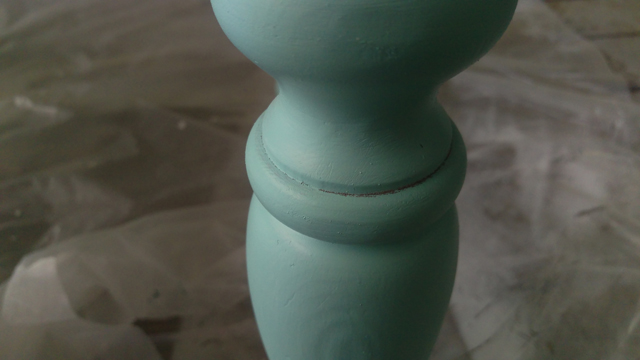
I picked up cheap (but not too cheap—they still have to be soft) watercolor brushes at the local craft store to touch up the nooks and crannies.
Once everything had dried for at least 24 hours, I peeled off the protective plastic cover and cracked open the stain. It’s runnier than paint but not as thin as water; it’s probably closest to Polycrylic in stir-ability.
I used a cheap foam brush to apply the stain; I aimed for thin and even coats. The instructions say not to allow it to sit for more than 3 minutes before wiping. Now, I generally regard these kinds of instructions as guidelines only. In this case, however, I would say that they are not kidding. The minute you brush on the whitewash stain it starts to become unbelievably sticky, so if you don’t wipe it off within three minutes it’ll be too gummy to get it off properly. I paused to take the photo below while applying the first coat and regretted it. When I went to wipe off the excess, it smeared and left uneven patches of color. They were especially noticeable because the first coat is so subtle.
Here’s two coats.
The third coat is more discernible, but still quite faint.
I liked that the wood grain was visible, but I didn’t like how faint the white was after three coats. At this point, I decided to gamble. I’d had great success staining pine nightstands a rich espresso color by using Varathane’s water-based stain in Kona and simply brushing it on and then leaving it to dry. So I painted on another coat of the whitewash, this time quite thickly so that the stain would stay wet on the surface longer and allow me to go back and smooth out lap lines, and didn’t wipe it at all. (So rebellious, I know.) Lo and behold, the sky did not fall, the tables did not catch fire, and no one broke down my door to arrest me for ignoring the label.
Ultimately, the nightstands got five coats of whitewash (three light coats + two heavy coats) and the coffee table got three (one light coat + two heavy coats). There’s no distinguishable difference in final color.
One downside to this approach was that I ended up with stain in the cracks (for some reason, the cracks repelled any little drops of stain when I used a lighter hand). I was afraid of damaging the surfaces by scraping the cracks with something sharp like a straight blade, to say nothing of dulling the blade, so I used a plastic knife to chip out the stain. Well, peel it out is more apt, since the gobbets in the cracks were sticky.
The last step was to lightly sand the whitewash, which was slightly tacky even after fully drying, with fine sandpaper to prep it for the topcoat.
I followed up with a tack cloth, then a damp rag, then a dry one. To be extra sure there was nothing lurking in those cracks, I used our regular vacuum cleaner to them a once over.
I applied two coats of Polycrylic with a synthetic-bristle brush over the painted and stained portions of the tables. Because we had a spate rainy days, I brought everything inside to seal and dry—don’t worry, I made sure the living room floor was covered and the air was well-ventilated—so there are no photos of this step.
Everything got another 48 hours or so to fully cure. What had once looked like this…
…now looks like this!
A huge improvement, no?
This was definitely a learning experience, and if I were to do it again, there are some things I would do differently (not the least of which is avoiding anything that has so many crevices that must be painted or not-painted). For one thing, I’d take a lighter hand when sanding to prep for the topcoat; I wasn’t gentle enough in spots and the wood shows through ever so slightly along a couple of the edges. For another thing, I would be more careful with the vacuum cleaner. While trying to get every last bit of dust out of the cracks, I left a few dark scuff marks, but I didn’t notice them until after I started applying the topcoat, so they’re sealed in forever. Is the finished product less than perfect? Yep. Are these things deal-breakers? Absolutely not! It’s all par for the course.
We’re so pleased to have the tables back in use and looking so pretty. They are, however, putting the lamps and throw pillows to shame, so I’m hoping to give those a little TLC next. Cheery colors for all the things!

